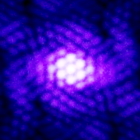| midtskogen | Date: Saturday, 10.12.2016, 19:55 | Message # 16 |
 Star Engineer
Group: Users
 Norway
Norway
Messages: 1674
Status: Offline
| Quotemccordengineering (  ) This, in a nutshell, is how I see black holes as an engineer. Is it totally insane or does some of it make sense?
I'm an engineer as well, but I don't think it makes sense (but perhaps no less sense than reality!)
First, a golf ball sized black hole would capture light within a golf ball diameter. It would bend light beyond that diameter, but I think that the effect is practically zero a mile away, or about the same bending that Earth in full size causes.
Then, is the pressure inside a lightweight singularity larger than inside a heavyweight singularity? Mathematically, there is no inside of a singularity. A singularity has infinite density and infinite temperature. It doesn't make sense to say that some singularities have more infinite density than others. So for your ideas to work, you need to abandon the idea of a singularity.
NIL DIFFICILE VOLENTI

Edited by midtskogen - Saturday, 10.12.2016, 19:55 |
| |
| |
| Watsisname | Date: Sunday, 18.12.2016, 02:48 | Message # 17 |
 Galaxy Architect
Group: Global Moderators
 United States
United States
Messages: 2613
Status: Offline
| Quote mccordengineering (  ) Anyway, my understanding is that if the entire earth is crushed down to pure mass, it would be about the size of a golf ball.
A little bit smaller -- 17.7mm in diameter, or a bit less than half the size of a golf ball. For those in the United States, it is about the size of a dime.
Quote midtskogen (  ) It would bend light beyond that diameter, but I think that the effect is practically zero a mile away, or about the same bending that Earth in full size causes.
Actually, exactly the same.  The gravitational field outside any spherically symmetric mass is exactly the same as if it were instead a point with the same mass. This is also the basis of the common statement that if you turned the Sun into a black hole, the orbits of the planets would be unchanged. The gravitational field outside any spherically symmetric mass is exactly the same as if it were instead a point with the same mass. This is also the basis of the common statement that if you turned the Sun into a black hole, the orbits of the planets would be unchanged.
So, a black hole with the mass of the Earth, being a little under 1cm in radius, would also capture light in the range of about a centimeter. And the deflection of light anywhere beyond 6371km (the former radius of the Earth) would be exactly the same as it currently is for the Earth! The gravitation would only be stronger inside the Earth's former radius, and would not become extreme (like in the strongly light-bending relativistic sense) until within a meter of it. For light to be deflected by just one degree of angle, it must miss by 1.017 meters.
Quote mccordengineering (  ) Now, if we accept that the volume of the earth can be compressed into a 1.68 inch diameter sphere, by applying the same compression ratio to the total mass of the known universe, everything could be compressed into a black hole mass that is roughly the size of Saturn. If we include the mass of dark matter, the diameter of the mass is still about the size of Jupiter. If that is the case, the diameter of even massive black holes throughout the universe would have to be less than a few miles.
Your analysis is well reasoned, but you are wrong to use the same compression ratio. A black hole is not formed at a unique density -- more massive black holes have lower density! This is because the size of the event horizon grows in direct proportion to the mass, so if you define the density as the mass of the black hole divided by the volume of its event horizon, then its density decreases as the square of the mass. The Earth would have to be compressed to far greater than nuclear densities to become a black hole, whereas for 100 million solar masses, it must only reach the density of water!
Another way to approach this is by noting that the size of any black hole depends only on its mass -- the formula is 2GM/c2. A black hole with 100 million solar masses has a radius of nearly 2AU.
Of course, the mass distribution inside a black hole does not remain at that density -- according to classical general relativity it collapses to a singularity of infinite density. (In reality, this is probably wrong, but it certainly does collapse to an extremely small size). But the size of the black hole's event horizon does not care about what is happening inside. It only cares about how much mass is enclosed. Once the distribution of mass lies within a sphere with the radius given above, the event horizon forms and it is a black hole.
Quote mccordengineering (  ) Is it totally insane or does some of it make sense? Do we really have to get into all the weird relativity stuff to discuss the shrapnel of the biggest blast in the universe?
Relativity is required to understand both the Big Bang and a black hole, but these two things are also very different. A black hole is a region of space where you have very strong gravitational field, surrounded by much weaker gravitational field. The distribution of mass is like having a point surrounded by vacuum. But the Big Bang and expanding universe is not like this -- it has the same density everywhere, and so there is no gravitational center to which everything is being attracted. In general relativity, these situations are described by different equations, and they have different behavior. The expanding universe is not like an exploded black hole.
Black holes actually can explode, but purely by a quantum mechanical process where they evaporate their mass away as radiation. The rate at which the mass is radiated increases as the mass decreases, so the final moment of evaporation looks like a bang. The last microsecond of evaporation of a black hole radiates about 2300kg of mass-energy, which is equivalent to 2x1020 joules, or almost 50 gigatons of TNT. Impressive, but no Big Bang. 

|
| |
| |
| mccordengineering | Date: Wednesday, 11.01.2017, 18:36 | Message # 18 |
|
Observer
Group: Newbies
 Pirate
Pirate
Messages: 2
Status: Offline
|  Thank you for all the responses. Thank you for all the responses.
I'm familiar with much of the theory, but I'm questioning if much of it is designed to make the big bang work with mathematics, such as as singularity, or is this assumed to be the real objects and things that actually happen. Does everything come from a single point, or could it be a Saturn size mass?
I guess my definition of the size of a black hole isn't correct. I suppose, when trying to measure a black hole, the diameter within which light disappears is all that can be used since there isn't much way to determine the diameter of the mass itself other than determining its gravitational field and the size of the near infinitely dense mass that would cause it.
What I am defining as the size of a black hole is the diameter of the mass itself, not the event horizon. By this definition, a black hole the size of a basketball would be massive. All black holes would have the same density since they are pure mass.
Is there a question about the actual density of the mass that makes up the black hole, or simply different definitions of how the size of a black hole is determined?
My biggest question is whether the massive black holes that became centers of nearly every galaxy might simply be chunks of the original black hole that exploded to form the known universe. This makes sense to me, but I haven't heard anyone suggest it. Is there a reason this is impossible?
Edited by mccordengineering - Saturday, 28.01.2017, 23:00 |
| |
| |